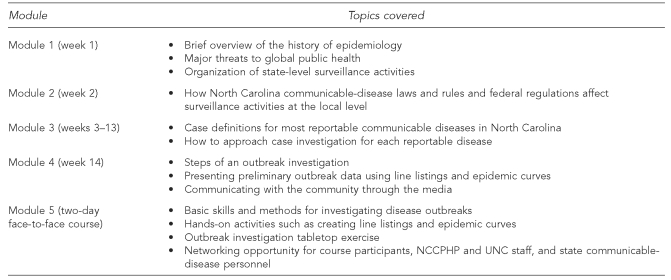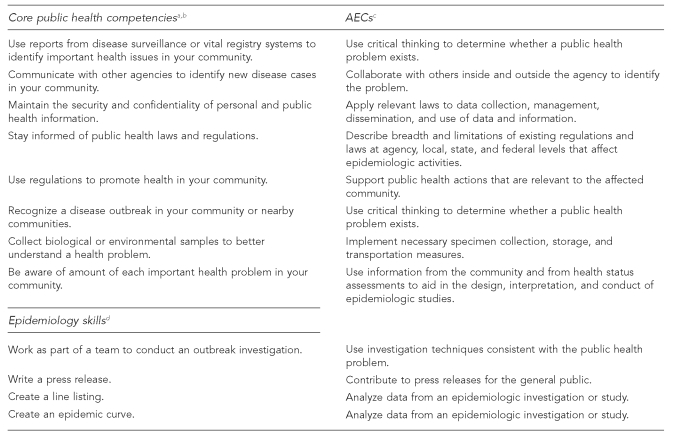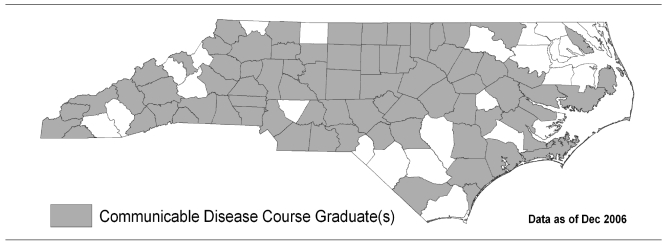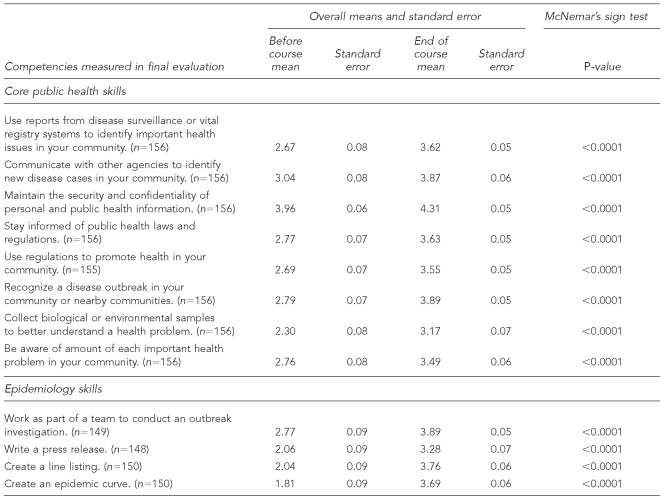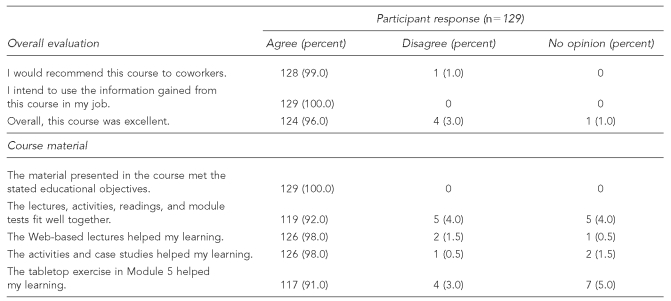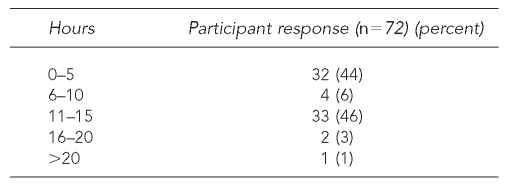SYNOPSIS
In 2004, the General Communicable Disease Control Branch of the North Carolina Division of Public Health and the North Carolina Center for Public Health Preparedness partnered to create a free continuing education course in communicable-disease surveillance and outbreak investigations for public health nurses. The course was a competency-based curriculum with 14 weeks of Internet-based instruction, culminating in a two-day classroom-based skills demonstration.
In spring 2006, the course became mandatory for all public health nurses who spend at least three-fourths of their time on tasks related to communicable diseases. As of December 2006, 177 nurses specializing in communicable diseases from 74 North Carolina counties had completed the course. Evaluations indicated that participants showed statistically significant improvements in self-perceived confidence to perform competencies addressed by the course. This course has become a successful model that combines academic expertise in curriculum development and teaching technologies with practical expertise in course content and audience needs. Through a combination of Internet and classroom instruction, this course has delivered competency-based training to the public health professionals who perform as frontline epidemiologists throughout North Carolina.
In North Carolina's local health departments, public health nurses perform basic applied epidemiology functions (known as Tier-1). In this role, public health nurses respond to disease reports received from clinicians, and recognize, investigate, and report disease outbreaks to the state health department.1 Although they must carry out these roles, public health nurses often do not have sufficient training in the related tasks. To enhance public health epidemiologic capacity and response, it is critical to train public health nurses in performing disease surveillance and conducting outbreak investigations.
Both the academic public health community and the state division of public health have worked to identify the training needs of public health nurses in North Carolina in disease surveillance and outbreak investigation. In 2003, the North Carolina Center for Public Health Preparedness (NCCPHP) in the North Carolina Institute for Public Health at the University of North Carolina School of Public Health (UNC SPH), Chapel Hill, North Carolina, developed and implemented a comprehensive self-assessment survey based on available published competencies, including core public health and emergency preparedness and response competencies.2–4 This assessment requested that public health workers identify their training needs and rate the importance of different competencies for their jobs. According to NCCPHP's assessment of 1,935 local North Carolina public health nurses, 41% indicated that being able to recognize a disease outbreak in their community or nearby communities was of high importance to their jobs and that they had a high need for training in this area. This information was further supported by a national report on the public health workforce that found that training in epidemiology and other core public health concepts was needed but difficult to find.5
The state of North Carolina also had identified training needs of public health nurses. In 2003, a new communicable-disease control manual was published for distribution to local health departments. Leaders at the General Communicable Disease Control Branch (GCDCB) in the Epidemiology Section of the North Carolina Division of Public Health, part of the North Carolina Department of Health and Human Services in Raleigh, North Carolina, were uncertain whether mailing the manual as a stand-alone tool would result in desired knowledge changes, such that nurses would be able to recognize the new bioterrorist agents included in the manual. GCDCB decided that training on the manual was important and would more likely result in nurses acquiring the needed knowledge. In addition, GCDCB identified computer proficiency as a skill needed by public health nurses, particularly because disease reporting would soon be done with an entirely Internet-based system. GCDCB wanted public health nurses to become more familiar with using the Internet specifically and computers generally.
NCCPHP and GCDCB also identified common barriers to face-to-face training for public health professionals in North Carolina, including limited access to training for advanced public health topics (particularly in rural areas), limited budgets for travel to central locations for face-to-face training, limited availability of state-level trainers, high staff turnover that necessitated frequent retraining, and difficulties in taking time away from busy work schedules.5–7 In North Carolina, 40% of the state's population is considered rural as classified by the U.S. Census 2000.8 The NCCPHP assessment showed that most North Carolina public health nurses had Internet access at home (79%) or at work (89%), making a computer-based course both practical and feasible.4
Bringing these needs to the table, GCDCB and NCCPHP formed a partnership to develop a blended Internet/classroom-based course to train communicable-disease nurses in disease surveillance, outbreak investigation, and new bioterrorist agents. Generally, state partners provided course content and expertise about audience needs and assets. The academic partners provided curriculum development and distance-learning technical expertise and infrastructure. Together, these partners created a course entitled “Introduction to Communicable Disease Surveillance and Investigation in North Carolina” to enhance the public health capacity and response of local health departments in North Carolina.
The pilot course debuted in fall 2004 and is now part of the mandatory training for all North Carolina public health nurses who spend at least three-fourths of their time on tasks related to communicable-disease investigation. This article describes the key elements of the course and the successful partnership between a state public health department and an academic Center for Public Health Preparedness to produce a distance-education competency-based training course for key epidemiology personnel across the state.
METHODS
The partnership
Development and implementation of the “Introduction to Communicable Disease Surveillance and Investigation in North Carolina” course required close and ongoing collaboration between the state and NCCPHP. Several characteristics made the partnership particularly strong and mutually beneficial. First, there was a long-standing continuing education partnership among North Carolina state agencies, local public health departments, and UNC SPH. In addition, UNC SPH as a whole, and NCCPHP in particular, had extensive experience in the field of distance learning.7,9 NCCPHP staff also had expertise in public health surveillance, outbreak investigation, and field epidemiology, and in delivering training programs tailored to the needs of local public health workers.
Both entities had strong teaching credentials and other strengths related to planning course content. State communicable-disease personnel at GCDCB, assisted by NCCPHP staff, acted as primary instructors for the course, which blends Internet-based and classroom experiences. NCCPHP provided course development, technical support, and evaluation services. Both NCCPHP and GCDCB provided expert lecturers and course content, and answered content-related questions from the participants. In trainings related to the state's new communicable-disease manual, GCDCB provided content expertise and NCCPHP helped develop trainings. GCDCB provided knowledge of the target audience's strengths and limitations, which allowed the course design and level of technical support to be tailored to the specific needs of communicable-disease nurses in North Carolina.10
The course
The course was divided into five modules. Modules 1 through 4 spanned 14 weeks and were completely Internet-based. Module 5 consisted of a two-day face-to-face class held at a central location in North Carolina. The Blackboard Learning System™ (Release 6.3.1), an Internet-based course management system, was used to deliver course content.11 Each participant was required to have an Internet connection and e-mail account, and to successfully complete an Internet-based skills test before enrollment.
The partnership between GCDCB and NCCPHP has maintained flexibility with regard to course content, ensuring that students acquire identified competencies and skills while allowing for changes in the role of nurses in applied epidemiology topic areas. Overall content has been closely tied to the communicable-disease nurses' state-mandated surveillance activities, emphasizing identified competencies as well as specific skills that GCDCB has deemed important for communicable-disease nurses in their reporting roles (Figure 1). Specific coursework has been mapped to core public health and emergency preparedness and response competencies.2,3 With the recent publication of the Council of State and Territorial Epidemiologists (CSTE)/Centers for Disease Control (CDC) Competencies for Applied Epidemiologists in Governmental Public Health Agencies (AECs), the modules are being reviewed and mapped appropriately to these new measures, independent of the current competencies. A preliminary mapping of the CSTE/CDC AECs to the course based on existing competencies suggests that these AECs will match well with the current competencies (Figure 2).1
Figure 1.
“Introduction to Communicable Disease Surveillance and Investigation in North Carolina” course content by module
NCCPHP = North Carolina Center for Public Health Preparedness
UNC = University of North Carolina
Figure 2.
Preliminary mapping of AECs to core public health competencies and epidemiology skills
Council on Linkages Between Academia and Public Health Practice. Core competencies for public health professionals: a practical tool to strengthen the public health workforce. The Link 2001;15:1-3. Also available from: URL: https://www.train.org/DesktopShell.aspx?tabid=94 [cited 2006 Nov 28].
Columbia University School of Nursing Center for Health Policy, Centers for Disease Control and Prevention (US). Bioterrorism and emergency readiness: competencies for all public health workers [cited 2006 Nov 28]. Available from: URL: http://www.cumc.columbia.edu/dept/nursing/chphsr/pdf/btcomps.pdf
Centers for Disease Control and Prevention (US) and Council of State and Territorial Epidemiologists. Competencies for applied epidemiologists in governmental public health agencies (AECs) [cited 2008 Mar 6]. Available from: URL: http://www.cdc.gov/od/owcd/cdd/aec or http://www.cste.org/competencies.asp
Epidemiology skills applicable to course were determined by course faculty.
AECs = applied epidemiology competencies for governmental public health agencies
For the first five courses (from fall 2004 through fall 2006), each Internet-based module was subdivided into units that consisted of an audio lecture with synchronized slides and additional readings or resources relevant to topics in that unit. Some units also contained specific activities, such as filling out North Carolina disease report cards and surveillance forms, interpreting laboratory results, and responding to essay questions about disease scenarios. Each module included a knowledge-based pre- and posttest activity. The module tests were identical multiple-choice instruments that asked knowledge questions related to that module's content. Once the pretest was submitted, participants could view their test results but were not given feedback about why certain responses were correct or incorrect; the participant gained this information by completing the module. After completing a module, participants completed the posttest, which provided explanations for all answers, both correct and incorrect. The course had a total of four pre- and posttest sets.
Upon successful completion of the course and submission of a course evaluation, participants received six continuing education units (10 contact hours = one unit) free of charge from the University of North Carolina at Chapel Hill. In addition, NCCPHP and GCDCB jointly issued an electronic certificate of completion to all participants who met the requirements described previously.
In Module 5, the face-to-face instruction at the end of the course, participants practiced specific competencies, such as creating line listings. In this module, they also conducted an epidemiology team investigation via a tabletop exercise, an important feature because 74% of course participants in the first five cohorts were members of their health department's epidemiology team. Observers examined each group's performance as an epidemiology team and reported on any problems encountered by the group. Module 5 observers have included course faculty, staff from UNC SPH and NCCPHP, personnel from GCDCB, and a group of hospital-based public health epidemiologists.
Finally, the course included an end-of-course evaluation that asked participants about their satisfaction with the course, including teaching methods, support, and materials. Additional questions addressed participant membership in epidemiology teams, course material preferences (electronic or hard copy), and time spent completing course materials. The end-of-course evaluation also included a participant self-assessment of confidence to perform skills and competencies addressed in the course. Using a retrospective pretest/posttest method, participants were asked to rate their confidence to perform eight public health competencies before starting the course and after completing the course, and to rate their confidence to perform designated epidemiology skills before and after attending the Module 5 face-to-face session.2,12 A McNemar's sign test was used to assess statistical significance of these pretest/posttest data. The evaluation process is currently being revised to reflect the AECs.
RESULTS
As of December 2006, a total of 177 communicable-disease nurses from 74 of 100 North Carolina counties had completed the course (Figure 3). Evaluation data were collected from 156 participants across five cohorts, from the fall 2004 pilot course to the fall 2006 cohort. A McNemar's sign test of evaluation data indicated that participants showed statistically significant improvements in self-perceived confidence to perform competencies addressed by the course (Table 1). Participant (n=129) satisfaction was exceptional: 99% of participants would recommend this course to coworkers and 96% agreed that the course was excellent. Furthermore, 100% intended to use the information gained in the course in their jobs (Table 2).
Figure 3.
Location of all North Carolina communicable-disease course graduates by county
Table 1.
Improvements in learner confidence to perform course competencies (measured on a scale of 1 to 5, where 1 is not at all confident and 5 is completely confident)
Table 2.
Course evaluation results
Participants indicated that course material met the stated objectives (100%) and agreed that the Internet-based lectures, as well as the activities and case studies, helped their learning (98% for each). Ninety-one percent of participants agreed that the Module 5 in-person exercise helped their learning. Only 4% of participants believed that the course materials did not fit well together (Table 2). The number of hours spent per week on course modules varied widely, with 44% of participants spending five hours or less per week and 46% spending 11 to 15 hours per week (Table 3).
Table 3.
Number of hours per week spent on course
DISCUSSION
Results of the evaluations indicated that course participants were highly satisfied with the course content and format. In addition, the course improved participants' self-confidence in performing competency-based skills such as creating a line listing or an epidemic curve. Further investigation needs to be done to determine whether this improvement in self-confidence has translated into improvements in job performance. In the future, course organizers plan to conduct a study of disease report cards submitted to the state health department by public health nurses to see whether the training course has impacted the quality of information collected. However, because the training is now reaching most of the communicable-disease nurses in the state, it will be difficult to gather a before-and-after snapshot that would delineate reporting changes attributable to the course. Now that the training is mandatory, it may be possible to conduct a longitudinal study comparing disease report cards from several years prior to the initiation of the course to disease report cards collected after the course was universally implemented. The small number of communicable diseases reported from many counties may make this analysis difficult. The other skills and competencies taught in the course may also be tested by looking at other relevant products, such as tabletop exercises, press releases, line listings, and epidemic curves. Staff turnover in these nursing positions must be factored into any such study.
The fact that this course has been made a mandatory training for North Carolina public health communicable-disease nurses validates the perceived importance of the course and emphasizes the lasting benefit of the partnership between NCCPHP and the state public health department. The development of the course through this partnership exemplifies the ideal of bringing the strengths of academia (such as expertise in distance learning and course development) to public health practice, which brings subject matter expertise and knowledge of the strengths and weaknesses of the target audience. Both partners were critical to designing a successful course.
Ongoing modifications are being made to the course in response to evaluation findings and emerging needs. The majority of these modifications are minor changes to course materials. Efforts are made to maintain currency through updating lectures and materials as needed when new information is available. In addition, the course has been modified since the initial pilot to reduce the amount of time required to complete each unit, in response to course evaluations showing that participants were spending significantly more time completing course activities than had been anticipated.
The fall 2006 course, the first cohort after the course became mandatory, was modified more significantly. First, Module 5 was condensed from a two-day to a one-day in-person training to minimize participant travel and lodging expenses. Second, the multiple module pre- and posttests were incorporated into an overall pre- and posttest for the entire course. Preliminary data from this new overall course evaluation indicate that this method measures similar knowledge improvement when compared to pre- and posttests given for each module.
With the incorporation of CSTE/CDC AECs, additional changes will be made to the course material as appropriate, and the evaluation will be adapted to address these newly adopted competencies. To ensure appropriate mapping of the AECs, the course content will be reviewed independent of the currently mapped competencies.
CONCLUSION
The development and implementation of “Introduction to Communicable Disease Surveillance and Investigation in North Carolina” illustrates a successful collaboration between a public health agency and academia. The course has become a mandatory training for communicable-disease nurses in North Carolina and has been shown to improve participants' self-confidence in performing competency-based skills. The course has also shown that blended learning using both Internet and classroom instruction can successfully deliver training to public health professionals. Based on the success of this work, the partners have gone on to create and implement a pandemic-influenza training course for local public health department staff in North Carolina. The partnership model discussed in this article has been demonstrated to be both effective and replicable for creating needed training for public health practitioners in applied epidemiology.
Acknowledgments
The authors thank Tara P. Rybka and Rachel A. Wilfert for editing the article.
Footnotes
This article was supported by grant/cooperative agreement #U90/CCU424255 from the Centers for Disease Control and Prevention (CDC) and contract number 01559-06 from the North Carolina Department of Health and Human Services, Division of Public Health (NCDPH). Its contents are solely the responsibility of the authors and do not necessarily represent the official views of CDC or NCDPH. The Public Health Institutional Review Board at the University of North Carolina at Chapel Hill approved the course evaluation and use of course data.
REFERENCES
- 1.Centers for Disease Control and Prevention (US) and Council of State and Territorial Epidemiologists. [cited 2008 Mar 5];Competencies for applied epidemiologists in governmental public health agencies (AECs) Available from: URL: http://www.cdc.gov/od/owcd/cdd/aec or http://www.cste.org/competencies.asp.
- 2.Council on Linkages Between Academia and Public Health Practice. [cited 2006 Nov 28];Core competencies for public health professionals: a practical tool to strengthen the public health workforce. The Link 2001;15:1-3. Also available from: URL: https://www.train.org/DesktopShell.aspx?tabid=94.
- 3.Columbia University School of Nursing Center for Health Policy, Centers for Disease Control and Prevention (US) [cited 2006 Nov 28];Bioterrorism and emergency readiness: competencies for all public health workers. Available from: URL: http://www.cumc.columbia.edu/dept/nursing/chphsr/pdf/btcomps.pdf.
- 4.North Carolina Center for Public Health Preparedness. North Carolina public health workforce training needs assessment final report. Chapel Hill (NC): University of North Carolina School of Public Health; 2003. [Google Scholar]
- 5.Health Resources and Services Administration (US) [cited 2006 Nov 28];National Center for Health Workforce Analysis. Public health workforce study, January 2005. Available from: URL: http://bhpr.hrsa.gov/healthworkforce/reports/publichealth/default.htm.
- 6.Steckler A, Farel A, Bontempi JB, Umble K, Polhamus B, Trester A. Can health professionals learn qualitative evaluation methods on the World Wide Web? A case example. Health Educ Res. 2001;16:735–45. doi: 10.1093/her/16.6.735. [DOI] [PubMed] [Google Scholar]
- 7.Umble KE, Shay S, Sollecito W. An interdisciplinary MPH via distance learning: meeting the educational needs of practitioners. J Public Health Manag Pract. 2003;9:123–35. doi: 10.1097/00124784-200303000-00005. [DOI] [PubMed] [Google Scholar]
- 8.Census Bureau (US) [cited 2006 Dec 5];United States Census 2000. Available from: URL: http://www.census.gov.
- 9.Alexander LK, Horney JA, Wallace JW, Davis M, Wilfert RA, MacDonald PDM. Guiding principles of a comprehensive Internet-based public health preparedness training program. Poster presented at the American Public Health Association 2006 Annual Meeting; 2006 Nov 4–8; Boston, MA. [Google Scholar]
- 10.Alexander LK, Dail K, Davis MV, Hajat A, Rothney E, Rybka T, et al. A pilot hybrid Internet/classroom-based communicable disease continuing education course for public health nurses in North Carolina: lessons learned. J Public Health Manag Pract. 2005;(Suppl):S119–22. doi: 10.1097/00124784-200511001-00020. [DOI] [PubMed] [Google Scholar]
- 11.Blackboard Inc. The Blackboard Learning System™: Release 6.3.1. Washington: Blackboard Inc.; 2003. [Google Scholar]
- 12.Bray JH, Maxwell SE, Howard GS. Methods of analysis with response-shift bias. Educ Psychol Meas. 1984;44:781–804. [Google Scholar]



